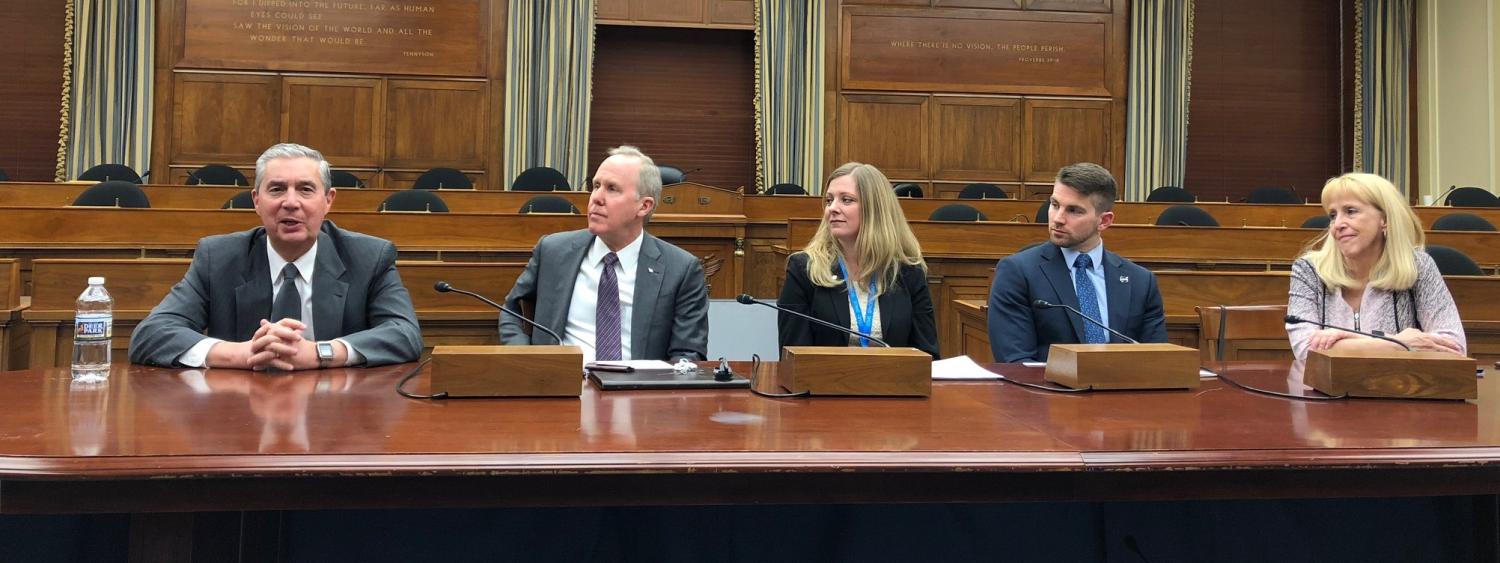Presentations

Jack Burns at Panel session on Capitol Hill in DC on the Moon to Mars program in April 2019.
Selected Invited Review Talks and Research Colloquia
For full list, please view Jack’s curriculum vitae (Download PDF file 1.6 MB).
- American Astronomical Society Meeting, Anchorage, AK, June 2012, invited lecture on “The Dark Ages Radio Explorer: Constraining Cosmic Dawn from the Global 21-cm Signal."
- Colloquium on “Space Science from the Moon”, NASA Headquarters, Washington, DC, November 2012.
- Conference on Bridging the Gap in Space Robotics, MIT, Cambridge, MA, July 2017, invited opening plenary lecture on “Planetary Surface Telerobotics."
- IAA Symposium, Torino, Italy, June 2017, invited presentation on “Science & Exploration at the Moon and Mars Enabled by Surface Telerobotics.”
- Kavli Symposium on U.S. Radio Futures III, Berkeley, CA, August 2017, invited presentation on “Low Frequency Radio Astronomy from Space.”
- NASA Exploration Science Forum 2017 at NASA Ames - The Elusive "Why" of Space Explorationon July 2017.
- NLSI Lunar Science Forum, July 2011, invited lecture “The Dark Ages Radio Explorer."
- Scientific Sense podcast, December 2020, Dr. Burns discusses NASA's Artemis program to travel to the moon and to establish a habitat there including an observatory, gateway that orbits with self propulsion and designing a launch pad for future exploration of the solar system including Mars. Listen now.
- University of Colorado Physics Department Colloquium, February 2021, Dr. Burns presented Radio Astrophysics from the Moon. Watch the recording.
Colloquia:
The Dark Ages Radio Explorer: University of Colorado, CASA, Jan. 2011; University of Waterloo, Canada, March 2011; Jet Propulsion Lab Caltech, Pasadena, CA, April 2011; University of New Mexico, Albuquerque, NM, April 2011; National Radio Astronomy Observatory, Socorro, NM, April 2011; Max Planck Institute for Radio Astronomy, Bonn, Germany, October 2011; NASA Ames Research Center, Moffett Field, CA, March 2012; Naval Research Laboratory, Washington, DC, April 2012; University of Toronto, Toronto, Canada, May 2012; Arizona State University, Tempe, AZ, October 2012; Trinity University, San Antonio, TX, January 2013; University of Texas at Austin, Austin, TX, February 2013; Brigham Young University, Provo, UT, October 2013; University of Colorado Boulder, Boulder, CO, January 2014; Space Telescope Science Institute, Baltimore, MD, February 2014; Stanford University, Palo Alto, CA, September 2014; University of California at Berkeley, Berkeley, CA, November 2014; Ball Aerospace Corporation, Boulder, CO, February 2015; National Radio Astronomy Observatory, Charlottesville, VA, March 2015; George Washington University, Washington, DC October 2015; New Mexico State University, March 2017.
Recent conference presentations:
Extraction of the Global 21-cm Signal from Foregrounds Using Dynamic Polarimetry and Pattern Recognition, Aspen Workshop on Cosmic Dawn, February 2018; Space Science and Exploration on the Lunar Farside Facilitated by Surface Telerobotics from the Deep Space Gateway, Science from the Deep Space Gateway Workshop, Denver, CO, March 2018; Space-based Observational Strategy for Characterizing the First Stars and Galaxies Using the Redshifted 21-cm Global Spectrum, American Astronomical Society meeting-in-a-meeting on Low Radio Frequency Observations from Space, Denver, CO, June 2018; Science On The Lunar Far Side Facilitated By Low Latency Telerobotics from the Lunar Orbiting Platform-Gateway; NASA Exploration Science Forum, NASA Ames Research Center, June 2018; A Unity of Purpose in Exploration and Space Science: Highlights from the SSERVI NESS Team, COSPAR 42nd General Assembly, Pasadena, CA, July 2018; Dark Cosmology: Searching for Dark Matter in the Dark Ages using the Global 21-cm Spectrum, Indentification of Dark Matter 2018 Conference, Brown University, Providence, RI, July 2018.

